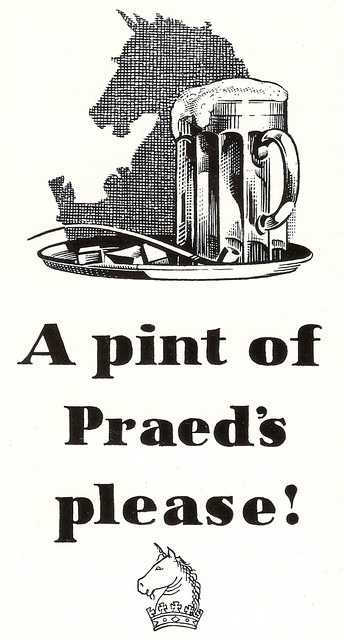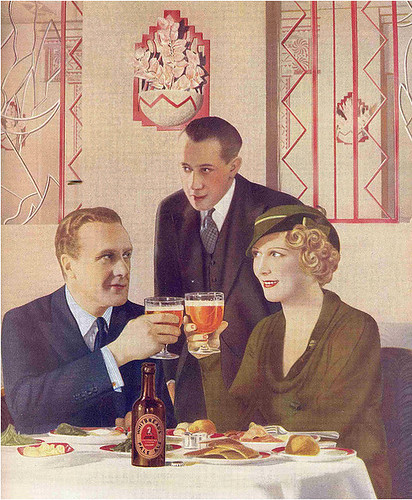
Today’s infographic comes from Charles Faram & Co., a UK hop merchant, showing the Family Tree of English Hop Varieties.
Auditing the Next Session
![]()
For our 73rd Session, our host is Adam W., who writes Pints and Pubs (from beer to eternity). His topic is all about something he does once a year, which he calls a “beer audit” and asking people to blog about their own efforts at managing their beer. Here’s what he means by a Beer Audit:
Once or twice a year I take a beer audit. I open cupboards and boxes and just have a good look at what’s there. Some beers get moved about, some make it from a box into the fridge, others get pushed further to the back of the cupboard for another day. Often I just stare at the bottles for a while and think about when I’ll drink them. Apart from the enjoyment of just looking at a hoard of beer, It tells me something about my drinking habits.
- I store too many bottles – over 150 at the last count, which would keep me in beer for over a month, compared to less than a week’s worth of food – but evidently that’s still not enough bottles as I return with more every time I leave the house.
- I have a tendency to hoard strong, dark beers – great for a winter evening, not so great when a lazy sunny afternoon starts with a 9% imperial stout and then gets stronger
- My cellaring could be improved. I found three beers from breweries that closed last year. I found these, not hidden away in a box under the stairs, but in the fridge. The fridge!!!
- My attempts to age beer usually just result in beer that’s past its best
- The oldest beer in my cupboard is probably an infant compared to the aged beers people must have in their cellars
So, I’m interested to know if you take stock of the beers you have, what’s in your cellar, and what does it tell you about your drinking habits. This could include a mention of the oldest, strongest, wildest beers you have stored away, the ratio of dark to light, strong to sessionable, or musings on your beer buying habits and the results of your cellaring. I look forward to reading your posts on Friday March 1st, leave a comment here when you do.
So this Friday, March 1, take stock of your own inventory, and take stock of taking stock.

So open up your beer cellar, or refrigerator, or closet, or wherever you store your beer, and let us know how you manage it by this Friday.
Beer In Ads #800: The Thirsty Soul’s Most Welcome Sight

Friday’s ad is for Barclay’s Lager, probably from around the 1930s. It’s another scraperboard illustration, and I love the poetic ad copy: “The Thirsty Soul’s Most Welcome Sight, Barclay’s Lager — Dark or Light.” And then there’s this bit of wisdom from the bottom of the ad, extolling Barclay’s Lager as “the drink for every kind of thirst.” Now that’s got me wondering about how many different kinds of thirst are there? Is there is list? Is it ranked by degrees of thirstiness? I need to know.
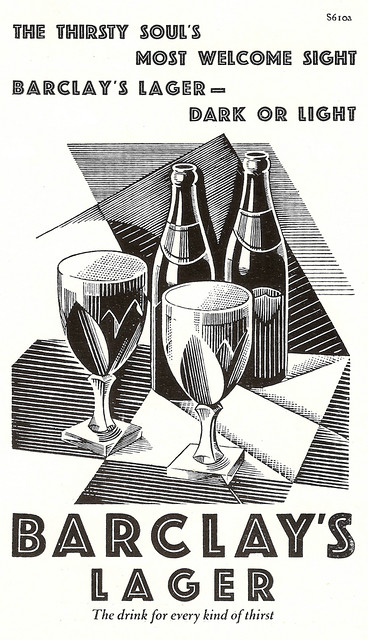
Beer In Ads #799: A Pint Of Praed’s Please!
Beer In Ads #798: You Will Enjoy …

Wednesday’s ad is for John Smith’s XXX, from around 1950. John Smith’s is a UK brand and although it’s not part of their current line-up of beers, I presume that the XXX was their strong beer. The smiling man holding the beer looks really familiar as a British comedian of the time, but I can’t quite place who it might be. Anyone have a thought?

Beer In Ads #783: What We Want Is Watneys

Wednesday’s ad is for Watney’s Dairymaid Stout, from what looks to be the 1970s, plus or minus. The first time I ever heard of Watney’s, probably like most Americans, was watching Monty Python, and their reference to “Bleedin’ Watney’s Red Barrel.” One interesting thing from the ad copy. It’s “the perfect mixer with most other beers.” I didn’t realize that was something people looked for in a beer. I also love the line at the bottom, mentioning another one of their stouts. “Watney’s Hammerton Stout: Brewed with Oatmeal & Glucose for Zest.” Yum, glucose. When was that a marketable ingredient?
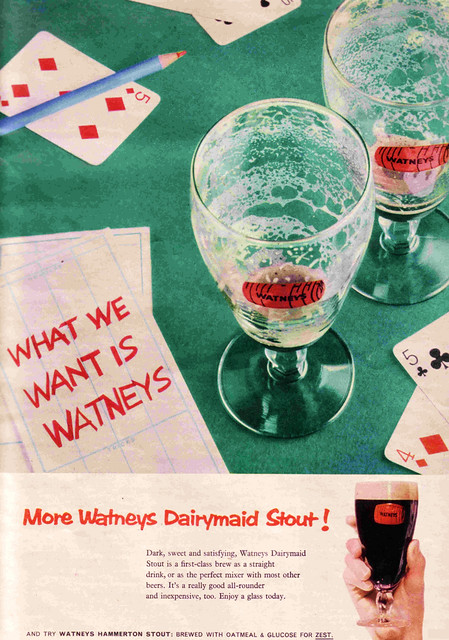
Beer In Ads #778: Loyal Greetings

Wednesday’s ad is for the UK brand Double Diamond, which was originally owned by Allsop, but is now part of the Carlsberg dynasty. The ad’s tagline, “Loyal Greetings from the brewers of Double Diamond,” and shows their cartoon mascot propping himself up, high into the air, on beer bottles so that he can better see the passing parade. As for when the ad is from, the bottom offers a clue. The phrase found there, “A Double Diamond Works Wonders,” was used during the 1970s. I assume there was some sort of royal ta-do going on.
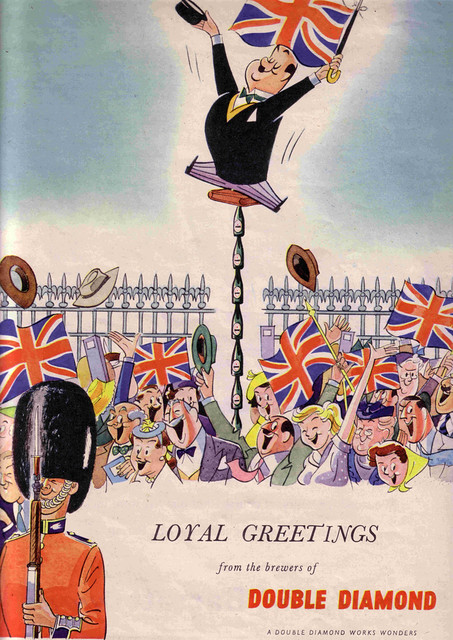
The Magic of Brewing, the Joy of Beer
![]()
Take a tour of the Suffolk brewery Greene King with head brewer John Bexon hosted by UK beer writer Roger Protz. The video, entitled The Magic of Brewing, the Joy of Beer, runs just under a half-hour and includes a tour of Greene King’s “traditional brew house and fermenting area, taking in the ancient wooden vats where Strong Suffolk is matured.” Enjoy.
Cornelius Caton, Of The White Lion Richmond

Here’s an interesting historical piece, from 1819-20. It was a four-volume set of books known as “Remarkable Persons,” though its full title was “Portraits, Memoirs, and Characters of Remarkable Persons From the Revolution in 1688 to the End of the Reign of King George II” and was subtitled “Collected from the most authentic accounts extant.” The full collection is available digitally at the Villanova University’s Farley Memorial Library, who describes the work as follows:
This collection contains the four volumes of: Portaits, memoirs, and characters, of remarkable persons: from the revolution in 1688 to the end of the reign of George II collected from the most authentic accounts extant by James Caulfield. “Caulfield’s ‘remarkable characters’ are persons famous for their eccentricity, immorality, dishonesty, and so forth.” — Dict. nat. biog. This work contains 155 engraved plates including work by engravers: George Cruikshank, W. Maddocks, Henry B. Cook, Robert Graves, and Gerard van der Gucht.
Another sources claims that it was a “collection of portraits and stories about the eccentrics of Britain in the 18th century by James Caulfield was issued by subscription in 1819 and 1820 to great success. It promised to satisfy the public fascination with ‘true stories’ about exceptional feats, physical peculiarities and notorious acts. The extent to which it actually contained ‘true stories’ is a matter for conjecture.” The one that caught my eye was a 19th century publican.

Plate 19 in Volume 3 depicts “Cornelius Caton, (Of the White Lion Richmond),” followed by his story on pages 173 through 175. Here’s his colorful story:
This little whimsical publican, having passed through the several gradations of pot-boy, , helper in the stables, and other menial offices attached to a public inn, at length rose to the important place of principal waiter: being of a complaisant temper, and possessing a species of low wit and pleasantry, he rendered himself so acceptable to the humour of the different guests which frequented the house, as to derive considerable perquisites from his ready desire to serve and accomodate the various description of persons whom business or pleasure drew to the place.
Caton carefully treasured up the money he obtained from time to time; until he had saved a sufficient sum to enable him to take the White-Lion public-house, at Richmond, in Surrey. The drollery of the landlord brought him considerable custom, which his attention to business so far improved as to make his house the most frequented of any in Richmond; and he became a general favourite with most of the inhabitants.
In person, he was one of the most grotesque appearance; and might have gained a livelihood bu exhibiting himself as a dwarf; this, joined with a certain oddity of manner, rendered him so conspicuous a character, as to bring him into great notice; and Cornelius Caton, and his house, found visitors from most parts of the adjacent villages in the neighbourhood.
He was well known to many persons in London; and, among others, George Bickham, the engraver, who deemed him of sufficient importance to speculate on engraving and publishing his portrait. This did not tend to diminish the number of Caton’s friends: and many have made a journey from town to Richmond, merely from curiosity of seeing the landlord of the White Lion.
A few years since, an equally singular personage, named Davis, a true son of Sir John Barleycorn, kept the Load-of-Hay public-house, on Haverstock-hill, near Hampstead; the eccentricity of whose personal appearance brought a considerable number of persons, particularly on a Sunday afternoon, and made the house a place of great trade.
Cornelius Caton was living at the time of his present majesty’s ascension to the throne, but the print of him was engraved in the reign of King George the Second.
You can see the original pages at Villanova digitalLibrary. Click on Volume 3 and scroll down to just before page 173, which is Plate 19.


